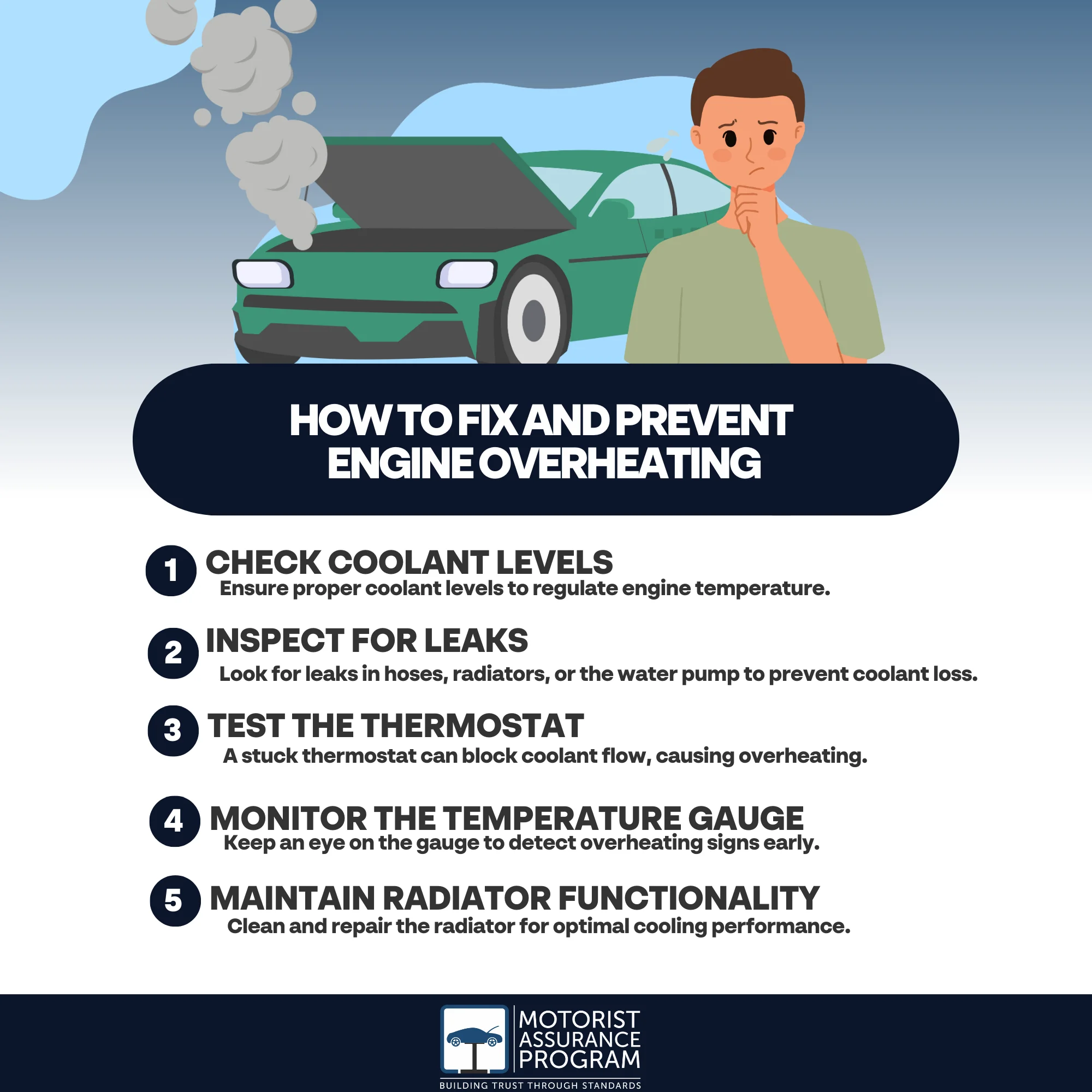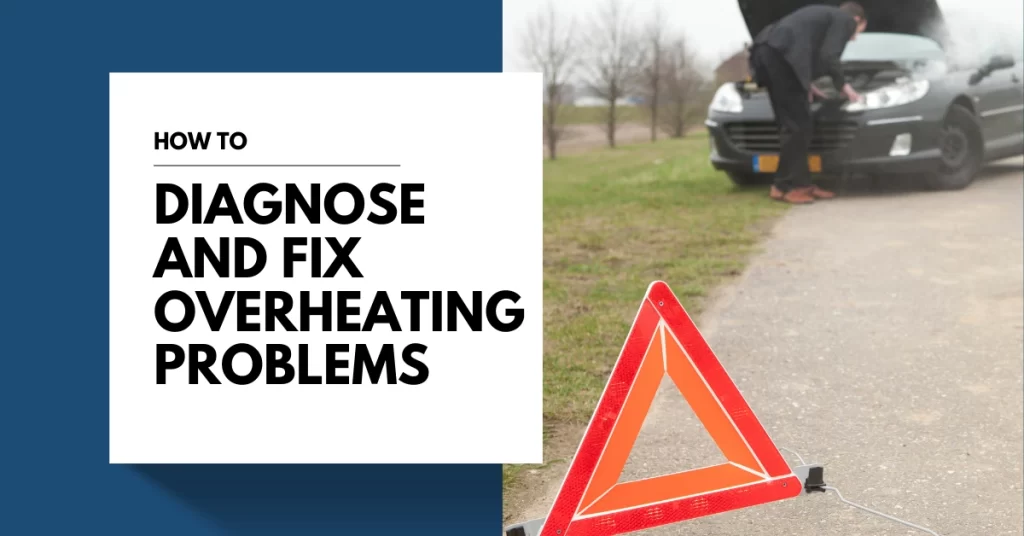To diagnose and fix overheating problems, first check the coolant level in the reservoir. Next, inspect for leaks in hoses or the radiator. A malfunctioning water pump or stuck thermostat may prevent effective coolant circulation. Listen for unusual engine sounds and monitor the temperature gauge for erratic spikes. If the gauge remains high, turn off the engine and let it cool down. If basic inspections don’t resolve the issue, seek professional assistance. Remember, routine checks can prevent these problems from developing. You’ll find useful insights on maintaining a healthy engine system ahead.

Key Takeaways
- Check the coolant level and refill if necessary, ensuring you use the correct type of coolant for your vehicle.
- Inspect for leaks in hoses and the radiator, looking for puddles or visible damage.
- Test the water pump for functionality, ensuring it circulates coolant effectively throughout the system.
- Examine the thermostat for proper operation to ensure it opens and closes as needed for coolant flow.
What is the difference between an engine and a cooling system?
When you think about your vehicle’s performance, it’s vital to distinguish between the engine and the cooling system. The engine is the powerhouse, converting fuel into mechanical energy, while the cooling system’s primary role is to regulate the engine’s temperature. An overheating engine signifies a failure in this critical balance.
To diagnose an overheating engine, start by examining the cooling system components. Check the coolant level; low coolant can lead to insufficient heat dissipation. Inspect the radiator for blockages or leaks that may inhibit airflow. Next, evaluate the thermostat; if it’s stuck closed, it won’t allow coolant to circulate properly, causing the engine to overheat.
You’ll also want to assess the water pump, as a malfunction here can prevent coolant from moving through the system. Pay attention to the hoses too; any cracks or deterioration can lead to leaks. Finally, monitor the engine temperature gauge during operation. A sudden spike indicates potential issues that require immediate attention. By systematically checking these elements, you’ll effectively diagnose the causes behind your overheating engine and take the necessary steps to rectify the problem.
Why do engines overheat?
Engines overheat due to several critical failures within the cooling system. You might encounter issues like a cooling system leak, a faulty water pump, or low coolant levels, all of which can compromise engine temperature regulation. Additionally, radiator fan or thermostat failures can further exacerbate overheating problems, leading to potential engine damage.
COOLING SYSTEM LEAK
A significant cause of engine overheating is a cooling system leak, leading to a loss of coolant and disrupting the engine’s ability to regulate temperature. When coolant escapes, the engine may not receive adequate cooling, resulting in elevated temperatures. Identifying a leak is essential, as it not only impacts engine performance but can also cause severe damage if left unaddressed.
To diagnose a cooling system leak, start by inspecting hoses and connections for visible signs of wear or damage. Look for puddles of coolant under the vehicle, and check the radiator and reservoir for cracks or corrosion. If you can’t find any visible leaks, consider using a pressure tester to pressurize the system, which can help pinpoint hidden leaks.
Once you’ve identified the source, repairing it may involve replacing damaged hoses, tightening loose clamps, or sealing cracks. Remember, keeping the cooling system in good condition is critical to preventing overheating. By knowing how to fix car overheating problems related to leaks, you can guarantee your engine operates efficiently and safely. Regular maintenance and inspections will help catch these issues before they escalate.
FAULTY WATER PUMP
Failing to circulate coolant effectively, a faulty water pump can considerably contribute to engine overheating. If your engine is running hotter than normal, it’s essential to check the water pump’s functionality. The water pump plays a important role in maintaining the engine’s temperature by ensuring coolant flows through the engine and radiator.
Here are four signs of a faulty water pump:
- Coolant Leaks: Puddles of coolant under your vehicle may indicate a failing water pump seal.
- Overheating Engine: If the engine overheats even after adding coolant, the pump might not be circulating it properly.
- Strange Noises: Unusual whining or grinding sounds can signal a malfunctioning water pump.
- Steam from the Engine: Excess steam often indicates an overheating engine due to inadequate coolant circulation.
To address how to fix overheating problems caused by a faulty water pump, consider replacing the pump if you notice any of these signs. Regular maintenance and inspections can help prevent issues before they escalate, ensuring your engine runs smoothly and efficiently.
LOW COOLANT LEVELS
Low coolant levels can lead to significant overheating issues in your vehicle, as the coolant is vital for regulating engine temperature. When the coolant isn’t at the proper level, it can’t effectively absorb and dissipate heat generated by the engine. This can result in an increase in engine temperature, potentially leading to severe damage if not addressed promptly.
To diagnose an overheating car caused by low coolant, start by checking the coolant reservoir. If the level is below the minimum mark, refill it with the appropriate coolant mixture. Next, inspect for possible leaks. Look for puddles under your vehicle or wet spots around hoses and connections. If you notice any, it may indicate a leak that needs repair.
Additionally, monitor the temperature gauge on your dashboard. If it consistently runs high, it’s a sign that the coolant may be inadequate. Regularly checking your coolant levels can prevent overheating and guarantee your engine runs smoothly. Remember, maintaining the right coolant level is essential for ideal engine performance and longevity.
RADIATOR FAN FAILURE
Insufficient coolant isn’t the only reason engines overheat; radiator fan failure is another significant factor. When your radiator fan isn’t functioning properly, it can’t effectively cool the engine, leading to elevated temperatures. Here’s how to diagnose and fix overheating in a car related to radiator fan issues:
- Check the Fan Operation: Start your engine and observe if the radiator fan engages when the engine reaches operating temperature. If it doesn’t, there’s likely an electrical issue or a faulty fan motor.
- Inspect the Fan Relay and Fuses: A blown fuse or a failed relay can prevent the fan from receiving power. Test these components and replace them if necessary.
- Examine Wiring and Connectors: Look for any damaged wiring or loose connections that might disrupt the electrical flow to the fan. Repair or replace any faulty components.
- Assess the Fan Blade Condition: Physical damage to the fan blades can impede airflow. If they’re cracked or broken, you’ll need to replace the fan assembly.
THERMOSTAT FAILURE
When your engine struggles to maintain an ideal temperature, a malfunctioning thermostat might be the culprit. The thermostat regulates coolant flow between the engine and radiator, guaranteeing optimal operating temperatures. If it fails to open or close properly, your engine can overheat. A stuck closed thermostat restricts coolant flow, causing excessive heat build-up. Conversely, a stuck open thermostat prevents the engine from reaching its proper temperature, leading to inefficient performance.
To diagnose thermostat failure, start by checking the temperature gauge. If it consistently reads high while the engine is running, it’s a clear sign of trouble. You can also feel the upper radiator hose; if it remains cool when the engine is hot, the thermostat likely isn’t opening.
To fix an overheated engine caused by a faulty thermostat, replace it with a new one. Make sure you drain the coolant before removal and follow manufacturer specifications for installation. After replacing the thermostat, refill the system with the appropriate coolant and bleed any air pockets. Regular checks can prevent future issues, making certain your engine runs efficiently and stays cool.
What are the signs of an engine overheating?
Noticing the signs of an engine overheating is essential for maintaining your vehicle’s health and safety. Ignoring these signs can lead to severe damage and costly repairs, often leaving you wondering how much to fix an overheating car. Here are four key indicators to watch out for:
- Temperature Gauge: If your temperature gauge rises into the red zone, it’s a clear warning that your engine is overheating.
- Warning Lights: Look for dashboard warning lights, particularly the engine temperature light, which signals a problem.
- Unusual Smells: Pay attention to any burnt or sweet smells, which could indicate leaking coolant or overheating components.
- Steam or Smoke: If you see steam escaping from under the hood or notice smoke, stop your vehicle immediately, as this could mean imminent engine failure.
How should you troubleshoot an engine that is overheating?
After identifying the signs of an overheating engine, troubleshooting the issue promptly is critical to preventing further damage. First, pull over safely and turn off your engine. Allow it to cool before opening the hood to avoid burns. Check the coolant level in the reservoir; if it’s low, adding coolant could help, but make certain you use the correct type.
Next, inspect for leaks under your vehicle. A puddle of coolant may indicate a problem with hoses, the radiator, or the water pump. If you don’t see any leaks, listen for unusual sounds from the engine, which might indicate mechanical failure.
Once you’ve checked these basics, it’s time to diagnose the overheating car’s thermostat. A stuck thermostat can prevent coolant circulation, leading to overheating. If the problem persists, consider the radiator. Make certain it’s not blocked or damaged.
Lastly, keep an eye on the engine temperature gauge. If it continues to rise, you may need professional help to avoid catastrophic engine damage. Make a note of any unusual symptoms and share them with your mechanic for accurate diagnosis and repair.
Frequently Asked Questions
Can Overheating Damage My Engine Permanently?
Yes, overheating can permanently damage your engine. Prolonged high temperatures can warp metal components, degrade gaskets, and lead to catastrophic failures. Regular maintenance and monitoring can help prevent such irreversible damage to your vehicle.
How Often Should I Check My Coolant Levels?
You should check your coolant levels at least once a month and before long trips. Maintaining proper levels helps prevent overheating, ensuring your engine operates efficiently and prolonging its lifespan. Regular checks are essential for peak performance.
What Type of Coolant Is Best for My Vehicle?
Choosing the right coolant’s like selecting a potion for a magic spell; it must match your vehicle’s needs. Check the owner’s manual for specifications, and consider using a high-quality, manufacturer-recommended coolant for peak performance.
Are There Specific Vehicles More Prone to Overheating?
Yes, certain vehicles, especially older models or those not regularly maintained, are more prone to overheating. Factors like engine design, cooling system efficiency, and environmental conditions can considerably affect their susceptibility to overheating issues.
What Should I Do if My Engine Overheats While Driving?
If your engine overheats while driving, pull over immediately, turn off the engine, and allow it to cool. For instance, if you notice steam, it’s essential to avoid further damage by not continuing to drive.
Conclusion
By being vigilant and verifying essential vehicle components, you can combat coolant conundrums and conquer engine overheating. Remember to check your routinely coolant levels, thermostat, and radiator for reliable performance. Swiftly spotting signs of trouble can save you from costly complications and keep your car cruising confidently. With a proactive approach and a bit of persistence, you’ll guarantee your engine stays cool and maintains its marvelous machinery for many miles to come.


